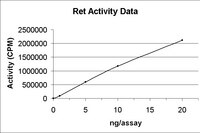14-570 Sigma-AldrichRet Protein, active, 10 µg
Active, N-Terminal GST-tagged, recombinant, human Ret amino acids 658-end, for use in Kinase Assays.
More>> Active, N-Terminal GST-tagged, recombinant, human Ret amino acids 658-end, for use in Kinase Assays. Less<<Recommended Products
Overview
| Replacement Information |
|---|
| Description | |
|---|---|
| Catalogue Number | 14-570 |
| Brand Family | Upstate |
| Trade Name |
|
| Description | Ret Protein, active, 10 µg |
| Overview | N-Terminal GST-tagged, recombinant, human Ret amino acids 658-end |
| References |
|---|
| Product Information | |
|---|---|
| Quality Level | MQ100 |
| Applications | |
|---|---|
| Application | Active, N-Terminal GST-tagged, recombinant, human Ret amino acids 658-end, for use in Kinase Assays. |
| Key Applications |
|
| Physicochemical Information |
|---|
| Dimensions |
|---|
| Materials Information |
|---|
| Toxicological Information |
|---|
| Safety Information according to GHS |
|---|
| Safety Information |
|---|
| Storage and Shipping Information | |
|---|---|
| Storage Conditions | 6 months at -70°C |
| Packaging Information | |
|---|---|
| Material Size | 10 µg |
| Material Package | Also available in 250 µg size --call for pricing and availability and reference catalog number 14-570M when ordering the 250 µg size. |
| Transport Information |
|---|
| Supplemental Information |
|---|
| Specifications |
|---|
| Global Trade Item Number | |
|---|---|
| Catalogue Number | GTIN |
| 14-570 | 04053252732812 |
Documentation
Ret Protein, active, 10 µg SDS
| Title |
|---|
Ret Protein, active, 10 µg Certificates of Analysis
| Title | Lot Number |
|---|---|
| Ret, active - 1627839-B | 1627839-B |
| Ret, active - 1627839-C | 1627839-C |
| Ret, active - 25850U-E | 25850U-E |








